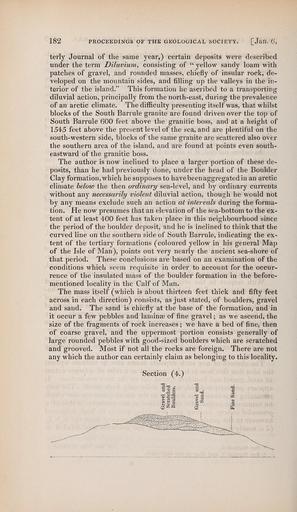MAKE A MEME
View Large Image

| View Original: | The_Quarterly_journal_of_the_Geological_Society_of_London_(13205760615).jpg (1199x2069) | |||
| Download: | Original | Medium | Small | Thumb |
| Courtesy of: | commons.wikimedia.org | More Like This | ||
| Keywords: The Quarterly journal of the Geological Society of London (13205760615).jpg 182 PROCEEDINGS OF THE GEOLOGICAL SOCIETY Jan 6 <br> terly Journal of the same year certain deposits were described <br> under the term Diluvium consisting of yellow sandy loam with <br> patches of gravel and rounded masses chiefly of insular rock de- <br> veloped on the mountain sides and filling up the valleys in the in- <br> terior of the island This formation he ascribed to a transporting <br> diluvial action principally from the north-east during the prevalence <br> of an arctic climate The difficulty presenting itself was that whilst <br> blocks of the South Barrule granite are found driven over the top of <br> South Barrule 600 feet above the granitic boss and at a height of <br> 1545 feet above the present level of the sea and are plentiful on the <br> south-western side blocks of the same granite are scattered also over <br> the southern area of the island and are found at points even south- <br> eastward of the granitic boss <br> The author is now inclined to place a larger portion of these de- <br> posits than he had previously done under the head of the Boulder <br> Clay formation which he supposes to havebeenaggregatedin an arctic <br> climate belotv the then ordinary sea-level and by ordinary currents <br> without any necessarily violent diluvial action though he would not <br> by any means exclude such an action at intervals during the forma- <br> tion He now presumes that an elevation of the sea-bottom to the ex- <br> tent of at least 400 feet has taken place in this neighbourhood since <br> the period of the boulder deposit and he is inclined to think that the <br> curved line on the southern side of South Barrule indicating the ex- <br> tent of the tertiary formations coloured yellow in his general Map <br> of the Isle of Man points out very nearly the ancient sea-shore of <br> that period These conclusions are based on an examination of the <br> conditions which seem requisite in order to account for the occur- <br> rence of the insulated mass of the boulder formation in the before- <br> mentioned locality in the Calf of Man <br> The mass itself which is about thirteen feet thick and fifty feet <br> across in each direction consists as just stated of boulders gravel <br> and sand The sand is chiefly at the base of the formation and in <br> it occur a few pebbles and laminae of fine gravel ; as we ascend the <br> size of the fragments of rock increases; we have a bed of fine then <br> of coarse gravel and the uppermost portion consists generally of <br> large rounded pebbles with good-sized boulders which are scratched <br> and grooved Most if not all the rocks are foreign There are not <br> any which the author can certainly claim as belonging to this locality <br> Section 4 <br> Ill <br> III <br> P <br> 1 <br> KffiB-55- <br> - _ <br> ~ ' Cj ˘ --;- – <br> - - -- '-- <br> ” 1 <br> ~ S 36932911 113687 51125 Page 182 Text v 3 http //www biodiversitylibrary org/page/36932911 1847 Geological Society of London NameFound Diluvium Biodiversity Heritage Library The Quarterly journal of the Geological Society of London v 3 1847 Geology Periodicals Smithsonian Libraries bhl page 36932911 dc identifier http //biodiversitylibrary org/page/36932911 smithsonian libraries Information field Flickr posted date ISOdate 2014-03-17 Check categories 2015 August 26 CC-BY-2 0 BioDivLibrary https //flickr com/photos/61021753 N02/13205760615 2015-08-26 12 54 08 cc-by-2 0 PD-old-70-1923 The Quarterly journal of the Geological Society of London 1847 Photos uploaded from Flickr by Fæ using a script | ||||